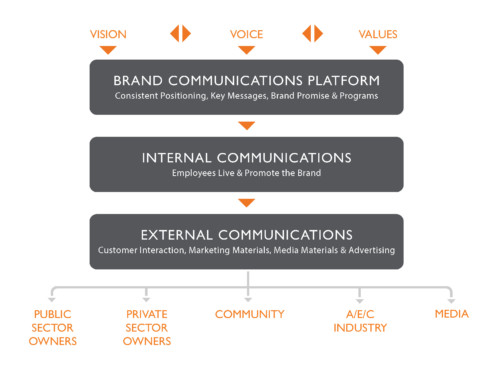If your competition understands branding and you don’t, then you are probably losing market share and revenue! Many Architects, Engineers, and Construction (AEC) firms are lean and mean, requiring them to keep overhead costs at a minimum in order to survive.
However, the firms who have taken the time to establish a brand presence are now the ones who are gaining market share at a staggering rate.
Historically, AEC firms believed brand was only a sharp logo, but it’s more than that. A strong brand allows a firm to be easily recognized, evokes positive feelings towards services you provide, and facilitates differentiation in the marketplace. It is well-defined, understood and measured within your market, and leverages a powerful image for your audience.
Some AEC firms do not realize branding strategies are different when dealing with services or products. In order to achieve the optimal results for your service organization, you must understand how the two differ.
Branding Products vs. Branding Services
First, AEC firms are primarily service-based, reputation-oriented organizations, and must approach branding differently than companies that are product-based. Service-based organizations’ offerings are typically intangible: where the value is based on a company’s perceived experience, rather than functionality. While products are something a client can physically touch, services are only as attractive as the solutions they can provide.
Next, services are generally more complex than products. Products are typically homogenous in nature, solving only one issue to the general public. Compared to a product with one purpose, a service holds several layers of value. More than likely an AEC firm offers multiple services, all of which must be properly communicated within the brand.
Finally, branding services rather than products is a more complex process. The steps for service-based organizations are more complex. They require a different set of research approaches and, must encompass not only the communication aspect of the brand but also cultural implementation.
7 Branding Steps for Architecture, Engineering, and Construction Firms
Step 1: Brand Measurement
A solid brand begins and ends with effective measurement. Prior to launching your brand, you must understand 3 things: your goals, the key performance indicators (KPI’s) to measure success, and predefined factors that will be benchmarked after the launch.
Step 2: Brand Understanding
The next step will be to understand where you currently are in the marketplace, and how to close the gaps in order to reach your future goals. Questions such as, “Who are we?”, “How are we perceived?”, and “What is our position in the marketplace?” are typically the key drivers of brand understanding.
In order to achieve your future goals, you must have an idea of where you currently stand against your competitors within the marketplace.
Step 3: Brand Definition
Defining your mission statement and vision for your organization is the next step of the branding process. Are you planning on providing innovative services to a specific group, or broadening your horizon to appeal to a larger number of clients?
During this phase you will identify your company’s values, describe the qualities and emotions your clients associate with your organization, define the personality of your brand, establish a brand promise, and target a clear and unique position in your marketplace.
Step 4: Brand Creation
Typically the most recognized part of the branding process, brand creation, represents all of the visual elements of your portfolio. Elements include division, product and corporate logos, color selections, letterhead designs, artwork and corporate font types. It is also the step where a memorable tagline is developed and communicated about the services you offer, voicing how you want to be viewed within the marketplace.
Step 5: Brand Communications
Brand communications align brand messaging with your organization’s goals, mission and vision. All branded corporate communications should be clear and relevant to your audience and represent the personality of the brand. A strong brand voice consolidates any scattered messaging into a consistent message that resonates with your target audience.

Step 6: Brand Living
Brand living is the most important step in the branding process. It empowers personnel to integrate the brand of your organization into their daily lives. This derives from a combination of effective training after the new brand has been identified, and instructions on how employees can properly represent their company within the marketplace.
Remember that every employee is an ambassador of your brand. They either contribute positively or negatively to your brand. Either way, they send messages to the marketplace with every public interaction. In order to positively execute your brand, make sure your employees are appropriately trained on your brand messaging, and ways they can positively contribute.
Step 7: Brand Management
Lastly, successful brands are managed. Proper management ensures internal and external communications align with the brand’s identity. Monitors are typically put in place to track brand consistency, effectiveness and alert if messaging goes off-brand. Some companies create a brand management team, while others outsource this function to a third party marketing agency. In order to effectively manage a brand, you have to put checks and balances in place.
Evaluate your new brand on a regular basis so that you stay the course of your goals. Understand that there may be a slight learning curve in the beginning, but be patient. As your brand strengthens, your organization will see an increase in customer loyalty, higher levels of market share and greater employee engagement.





